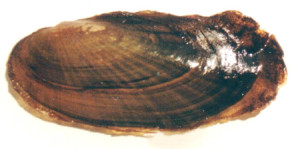Recent research by the University of Oklahoma has further highlighted the importance of mussel species to Oklahoma’s stream systems. Boaters and fishing enthusiasts might be familiar with the pesky, non-native zebra mussel. However, Oklahoma’s streams are host to native mussels that are vital to water quality and the food web.

Scaleshale (Leptodea leptodon), one of several imperiled aquatic species of the Kiamichi River basin.
Photo: Oklahoma Department of Wildlife Conservation
Mussels, often regarded as keystone species, are ‘filter feeders’ that are able to process large volumes of water. They filter suspended particles and recycle nutrients, which are essential functions of a healthy stream system that otherwise would not occur. In fact, mussels have been shown to reduce the cost of water treatment due to their ability to ‘clean’ the water by cycling nitrogen and storing phosphorus.
A scientific study published last year by Carla Atkinson, Jeffrey Kelly, and Caryn Vaughn shows that nitrogen supplied by mussels can be an important nutrient subsidy that provides food web support. Their research results suggest that with natural mussel aggregation up to 74 percent of nitrogen in the food web may be mussel-derived.
The Oklahoma Biological Survey characterizes the Ouachita Uplands as “one of the last strongholds of freshwater biodiversity in North America, and may represent one of the last strongholds of freshwater mussel biodiversity in the world.” North America was once considered to have the highest diversity of freshwater in the world, but more than 70 percent of the continent’s 302 mussel species are extinct or imperiled.
Are there threats to mussel species and habitat in Oklahoma? Yes. Mussel-species richness and abundance in the Kiamichi Basin is being impacted by how water is managed during a drought, according to a published scientific study by Daniel Allen, Heather Galbraith, Caryn Vaughn, and Daniel Spooner in 2013. Droughts complicate water management, because human demand for water is highest when water availability is lowest.
The 2013 study by Allen et al. compared 13 years of reservoir releases in the Kiamichi Basin to reservoir releases on the Little River during the same time period. Water releases into the Kiamichi were halted during periods of drought, whereas releases were made on the Little River.
The team conducted several mussel surveys in both rivers over this period of time to track changes in mussel species diversity and abundance. Results suggest that reduced releases during droughts likely led to mussel declines in the Kiamichi River, while maintaining reservoir releases may have sustained mussel populations in the Little River.”
It is especially important that the waters of Eastern Oklahoma remain pure to sustain that region’s economy and culture, which are directly driven by recreation, tourism, and wildlife. Furthermore, the health of Oklahoma’s watersheds are also important to our downstream neighbors in Texas, Arkansas and Louisiana. Historically, water quality issues have plagued both the Arkansas River and Red River, but mussels help alleviate water quality issues in these large rivers by filtering the water in their tributaries.